Allison Transmission 4000, 500 Service Manual
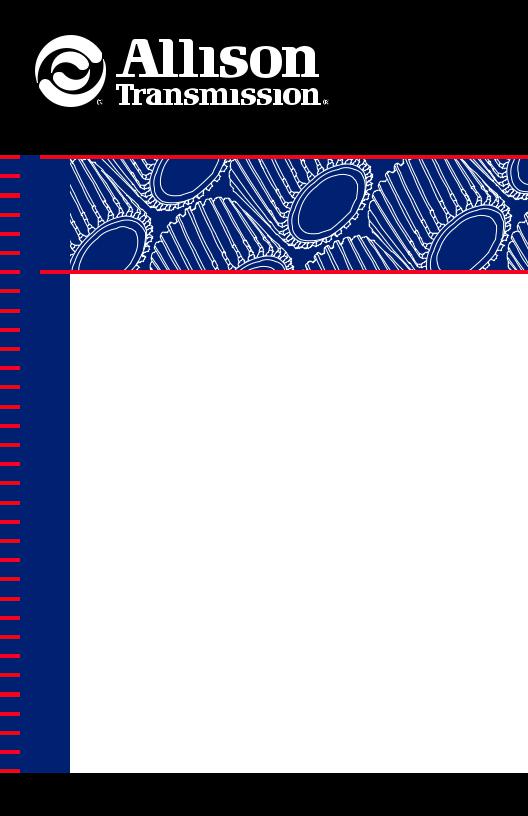
Operator’s M

 a
a


 nual
nual
AT,MT,HT Series








On-Highway Transmission
OM1334EN
MT4108EN

Operator’s
OM1334EN
Manual
Allison Transmission
AT 540
AT 542(N)(R)(NFE)
AT 543
AT 545(N)(R)
AT 1542P
AT 1545P(N)
MT 640, MT(B) 643, MT 643R, 644, 647
MT 650, MT(B) 653, 654CR
HT 740(D)(RS)(FS)
HT 747(D)
HT 750CRD, HT 750DR (DB)(RS)
HT 750DRI, HT 750DRD (DB)
HT 754CRD, HT 754CR (RS)
February, 2001
Allison Transmission, Inc.
P.O. Box 894 Indianapolis, Indiana 46206-0894
www.allisontransmission.com
Printed in U.S.A. |
i Copyright © 2007 Allison Transmission, Inc. |
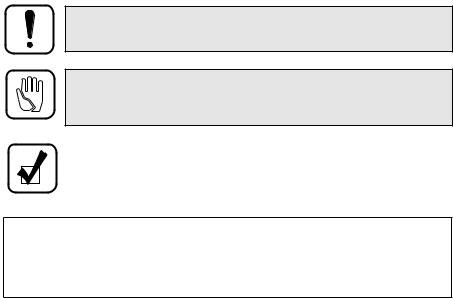
WARNINGS, CAUTIONS, AND NOTES
IT IS YOUR RESPONSIBILITY to be completely familiar with the warnings and cautions described in this handbook. It is, however, important to understand that these warnings and cautions are not exhaustive. Allison Transmission could not possibly know, evaluate, and advise the service trade of all conceivable ways in which service might be done or of the possible hazardous consequences of each way. Consequently, Allison Transmission has not undertaken any such broad evaluation. Accordingly, ANYONE WHO USES A SERVICE PROCEDURE OR TOOL WHICH IS NOT RECOMMENDED BY ALLISON TRANSMISSION MUST first be thoroughly satisfied that neither personal safety nor equipment safety will be jeopardized by the service methods selected.
Proper service and repair is important to the safe, reliable operation of the equipment. The service procedures recommended by Allison Transmission and described in this handbook are effective methods for performing service operations. Some of these service operations require the use of tools specially designed for the purpose. The special tools should be used when and as recommended.
Three types of headings are used in this manual to attract your attention. These warnings and cautions advise of specific methods or actions that can result in personal injury, damage to the equipment, or cause the equipment to become unsafe.
WARNING: A warning is used when an operating procedure, practice, etc., if not correctly followed, could result in personal injury or loss of life.
CAUTION: A caution is used when an operating procedure, practice, etc., if not strictly observed, could result in damage to or destruction of equipment.
NOTE: A note is used when an operating procedure, practice, etc., is essential to highlight.
TRADEMARK INFORMATION
DEXRON® is a registered trademark of General Motors Corporation. TranSynd™ is a trademark of Castrol Ltd.
ii
TABLE OF CONTENTS
Page
INTRODUCTION
Warnings, Cautions, And Notes . . . . . . . . . . . . . . . . . . . . . . . . . . . . . . . . . . . . . . ii Keeping That Allison Advantage . . . . . . . . . . . . . . . . . . . . . . . . . . . . . . . . . . . . . 1 Typical AT, MT, And HT Model Transmissions . . . . . . . . . . . . . . . . . . . . . . . . . 2 A Brief Description Of The Allison Automatic . . . . . . . . . . . . . . . . . . . . . . . . . . 3 Torque Converter . . . . . . . . . . . . . . . . . . . . . . . . . . . . . . . . . . . . . . . . . . . . . . . . . 3 Lockup Clutch (AT 1500, MT(B) 600, HT 700) . . . . . . . . . . . . . . . . . . . . . . . . . 3
SHIFT SELECTORS
Allison Automatics . . . . . . . . . . . . . . . . . . . . . . . . . . . . . . . . . . . . . . . . . . . . . . . . 6 Typical AT, MT, HT Shift Selector Positions . . . . . . . . . . . . . . . . . . . . . . . . . . . 6 Range Selection — AT 500 Series And AT 1500 Series With A Second
Neutral (Park) . . . . . . . . . . . . . . . . . . . . . . . . . . . . . . . . . . . . . . . . . . . . . . . . 7 Range Selection — AT 500 Series And AT 1500 Series Without A Second
Neutral (Park); MT 640, MT(B) 643, MT 643R, MT(B) 644, MT 647;
HT 740, HT 747. . . . . . . . . . . . . . . . . . . . . . . . . . . . . . . . . . . . . . . . . . . . . . . 9 Range Selection — MT 650; MT(B) 653DR . . . . . . . . . . . . . . . . . . . . . . . . . . . . 11 Range Selection — HT 750CR, HT 754CR, MT(B) 654CR . . . . . . . . . . . . . . . . 13 Range Selection — HT 750DR, HT 750DR DB . . . . . . . . . . . . . . . . . . . . . . . . . 15
DRIVING TIPS
Throttle Control . . . . . . . . . . . . . . . . . . . . . . . . . . . . . . . . . . . . . . . . . . . . . . . . . . 17
Downshift Inhibit Feature . . . . . . . . . . . . . . . . . . . . . . . . . . . . . . . . . . . . . . . . . . . 17
Operating In Cold Weather . . . . . . . . . . . . . . . . . . . . . . . . . . . . . . . . . . . . . . . . . . 17
Using the Engine For Downhill Braking To Slow The Vehicle
Or Equipment. . . . . . . . . . . . . . . . . . . . . . . . . . . . . . . . . . . . . . . . . . . . . . . . . 18
Using The Hydraulic Retarder . . . . . . . . . . . . . . . . . . . . . . . . . . . . . . . . . . . . . . . 18
Auxiliary Transmission. . . . . . . . . . . . . . . . . . . . . . . . . . . . . . . . . . . . . . . . . . . . . 20
Two-Speed Axle . . . . . . . . . . . . . . . . . . . . . . . . . . . . . . . . . . . . . . . . . . . . . . . . . . 20
Towing Or Pushing . . . . . . . . . . . . . . . . . . . . . . . . . . . . . . . . . . . . . . . . . . . . . . . . 20
Parking Brake . . . . . . . . . . . . . . . . . . . . . . . . . . . . . . . . . . . . . . . . . . . . . . . . . . . . 20
Driving On Ice Or Snow . . . . . . . . . . . . . . . . . . . . . . . . . . . . . . . . . . . . . . . . . . . . 21
Rocking Out . . . . . . . . . . . . . . . . . . . . . . . . . . . . . . . . . . . . . . . . . . . . . . . . . . . . . 21
Temperatures. . . . . . . . . . . . . . . . . . . . . . . . . . . . . . . . . . . . . . . . . . . . . . . . . . . . . 21
iii
Page
POWER TAKEOFF OPERATION
Engine-Driven PTO . . . . . . . . . . . . . . . . . . . . . . . . . . . . . . . . . . . . . . . . . . . . . . . 23
Converter-Driven PTO . . . . . . . . . . . . . . . . . . . . . . . . . . . . . . . . . . . . . . . . . . . . . 23
CARE AND MAINTENANCE
Periodic Inspections . . . . . . . . . . . . . . . . . . . . . . . . . . . . . . . . . . . . . . . . . . . . . . . 25
Prevent Major Problems . . . . . . . . . . . . . . . . . . . . . . . . . . . . . . . . . . . . . . . . . . . . 26
Importance Of Proper Fluid Level . . . . . . . . . . . . . . . . . . . . . . . . . . . . . . . . . . . . 26
Transmission Fluid Check Procedure . . . . . . . . . . . . . . . . . . . . . . . . . . . . . . . . . . 27
Cold Check . . . . . . . . . . . . . . . . . . . . . . . . . . . . . . . . . . . . . . . . . . . . . . . . . . . . . . 28
Hot Check . . . . . . . . . . . . . . . . . . . . . . . . . . . . . . . . . . . . . . . . . . . . . . . . . . . . . . . 29
Dropbox Fluid Check Procedure . . . . . . . . . . . . . . . . . . . . . . . . . . . . . . . . . . . . . 29
Keeping Fluid Clean . . . . . . . . . . . . . . . . . . . . . . . . . . . . . . . . . . . . . . . . . . . . . . . 30
Recommended Automatic Transmission Fluid And Viscosity Grade . . . . . . . . . 30
Fluid And Filter Change Intervals . . . . . . . . . . . . . . . . . . . . . . . . . . . . . . . . . . . . 31
Fluid Contamination . . . . . . . . . . . . . . . . . . . . . . . . . . . . . . . . . . . . . . . . . . . . . . . 35
Auxiliary Filter . . . . . . . . . . . . . . . . . . . . . . . . . . . . . . . . . . . . . . . . . . . . . . . . . . . 37
CUSTOMER SERVICE
Owner Assistance . . . . . . . . . . . . . . . . . . . . . . . . . . . . . . . . . . . . . . . . . . . . . . . . . 38
Service Literature . . . . . . . . . . . . . . . . . . . . . . . . . . . . . . . . . . . . . . . . . . . . . . . . . 40
Allison Transmission Distributors . . . . . . . . . . . . . . . . . . . . . . . . . . . . . . . . . . . . 41
Allison Transmission Regional Offices . . . . . . . . . . . . . . . . . . . . . . . . . . . . . . . . 44
iv
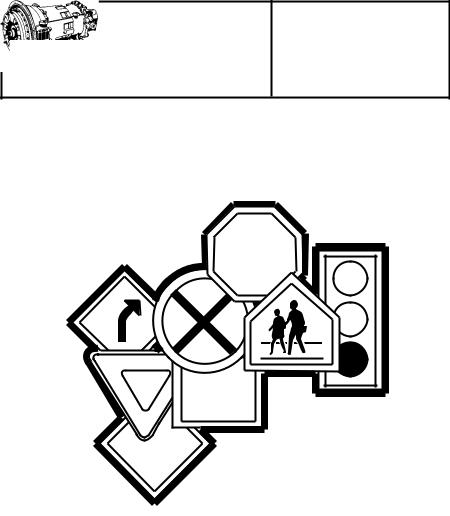
INTRODUCTION
KEEPING THAT ALLISON ADVANTAGE
STOP
R R
Y I E L D SPEED
ZONE
HILL
V01724
Allison automatics provide many advantages for the driver who must “stop and go” or change speeds frequently. Driving is easier, safer, and more efficient.
These automatics are rugged and are designed to provide long, trouble-free service. This handbook will help you gain maximum benefits from your Allison-equipped vehicle.
1
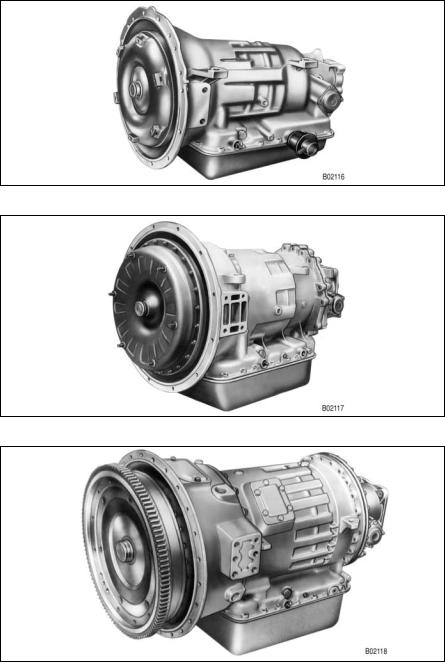
TYPICAL AT, MT, AND HT MODEL TRANSMISSIONS
AT Model Transmission
MT Model Transmission
HT Model Transmission
2
A BRIEF DESCRIPTION OF THE ALLISON AUTOMATIC
Allison automatics described in this manual include a hydraulic torque converter, a planetary gear train, and a hydraulic control system which supplies fluid under pressure to apply the clutches and automatically shift ranges.
The torque converter multiplies engine torque during starts and acts as a hydraulic cushion between the engine and gearing. The clutches and gear sets provide multiple speeds forward and one speed reverse.
The torque converter lockup clutch, for maximum fuel economy, engages automatically after the vehicle is moving. All models in this manual, except AT 500, have a lockup clutch.
TORQUE CONVERTER
The torque converter consists of three elements — pump, turbine, and stator. The pump is the input element and is driven by the engine. The turbine is the output element and is driven by fluid from the pump, or directly by the pump when the lockup clutch is engaged. The stator is the reaction (torque multiplying) element.
The torque converter is continuously filled with fluid. The pump, driven by the engine, directs the fluid against the turbine vanes, which causes the turbine to rotate. The turbine returns the fluid through the stator, which redirects the flow so that fluid strikes the pump vanes in the same direction that the pump is rotating. As the pump turns faster in relation to the turbine, the velocity of the fluid increases and so does the torque multiplication.
As the speed of the turbine approaches the speed of the pump, the fluid flow starts striking the back sides of the stator vanes. This causes the stator to freewheel in the same direction as the pump and turbine. When this occurs, the torque multiplication stops and the converter functions as a fluid coupling.
LOCKUP CLUTCH (AT 1500, MT(B) 600, HT 700)
The lockup clutch consists of three elements — piston, clutch plate, and backplate. The piston and backplate are driven by the engine. The clutch plate, located between the piston and backplate, is splined to the converter turbine.
The lockup clutch automatically engages after the vehicle is moving and the torque multiplication demand is low. Engagement of the lockup clutch mechanically connects the torque converter pump to the turbine and provides a direct drive from the engine to the transmission. The lockup clutch automatically releases at lower vehicle speeds. When the lockup clutch is not engaged, drive from the engine is transmitted hydraulically through the converter to the transmission gearing.
3
Because the converter lockup engagement and release are designed to fit the vehicle’s vocation, there are many variations among transmission assemblies. Lockup speeds are determined by many factors. Among these are transmission-engine match, transmission-vehicle match, model year, throttle position, and calibration of the hydraulic system. Some models have lockup available in all ranges. Others have lockup available in the upper ranges. Some models have modulated lockup, which provides better engine braking by delaying lockup disengagement during closedthrottle operation. For specific information on the lockup characteristics of your transmission, contact your dealer or distributor.
Lockup engagement, like range shifts, may be felt under some conditions. The driver who counts shifts should not confuse lockup with a range change. A little driving experience with the Allison automatic will enable the driver to distinguish between the two kinds of shifts.
4
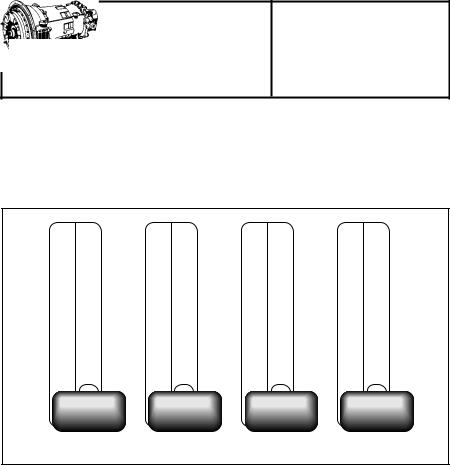
SHIFT SELECTORS
The vehicle manufacturers may choose different types of shift selectors for their equipment. Different transmission models may also require different designations on the shift selectors.
R |
R |
R |
R |
|
N |
N |
N |
N |
|
D |
D |
D |
D |
|
4 |
2-4 |
|||
3 |
2-4 |
|||
3 |
2-3 |
|||
2 |
2 |
|||
2 |
2 |
|||
1 |
1 |
1 |
1 |
V01958.01
Typical Shift Selector Labeling
These are some of the typical shift selectors you may find in Allison-equipped vehicles. The range selector in your vehicle may vary from these or may have
1 (First Range) at the top and R (Reverse) at the bottom. Some models may have a P (Park) position.
The best performance will be obtained by using the correct range for each driving condition. The following table illustrates shift patterns for the various models and indicates the page that explains the shift pattern for your vehicle.
5

ALLISON AUTOMATICS
P* |
R |
N |
V01959 |
|
MT 640, |
|
|
|
|
AT 500 |
MT(B) 643, |
|
|
|
|
Series And |
MT 643R, |
MT 650, |
|
HT 750CR, |
|
AT 1500 |
MT(B) 644◊ , |
MT(B) |
HT 740, |
HT 754CR, |
HT 750DR |
Series |
MT(B) 647 |
653DR |
HT 747 |
MT(B) 654CR◊ |
(DR DB) |
Park |
— |
— |
— |
— |
— |
Reverse |
Reverse |
Reverse |
Reverse |
Reverse |
Reverse |
Neutral |
Neutral |
Neutral |
Neutral |
Neutral |
Neutral |
1–4 |
1–4 |
2–5 |
1–4 |
1–5 |
2–5 |
1–3 |
1–3 |
2–4 |
1–3 |
1–4 |
2–4 |
1–2+ |
1–2 |
2 (2–3**) |
1–2 |
1–3 |
2–3 |
1 |
1 |
1 |
1 |
1–2 |
2 |
— |
— |
— |
— |
1 |
1 |
(Pages 7-10) |
(Pages 9-10) |
(Pages 11-12) |
(Pages 9-10) |
(Pages 13-14) |
(Pages 15-16) |
|
|
|
|
|
|
Typical AT, MT, HT Shift Selector Positions
When your vehicle is equipped with an Allison automatic, it is not necessary to select the right moment to upshift or downshift during the changing road and traffic conditions. The Allison automatic does it for you. A knowledge of the ranges available at your shift selector will make control of the vehicle and your job even easier.
When the shift selector has no P (Park) provision, always put the selector in N (Neutral) and apply the parking brake (or service brakes if the vehicle is not
equipped with a parking brake) to hold the vehicle when it is unattended and before turning off the engine.
* Available on AT 500 Series and AT 1500 Series models only (refer to Page 7). + This position not present on models with P (Park).
** Optional.
◊ Without second gear start.
6
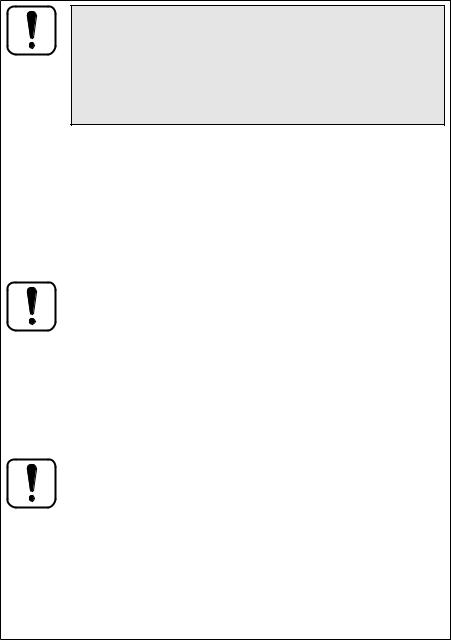
RANGE SELECTION — AT 500 SERIES AND AT 1500 SERIES WITH A SECOND NEUTRAL (PARK)
WARNING: If you leave the vehicle and the engine is running, the vehicle can move suddenly and you or others could be injured. If you must leave the engine running, do not leave the vehicle until you:
•Put the transmission in N (Neutral)...and
•Apply the parking brake and emergency brakes and make sure they are properly engaged...and
•Chock the wheels and take any other steps necessary to keep the vehicle from moving.
|
P |
|
|
This activates the vehicle parking brake and at the same time puts the |
||
|
|
|
|
transmission in neutral. Use this position when you start the engine. If the |
||
|
|
|
|
engine starts in any other position, except N (Neutral), the neutral start |
||
|
|
|
|
switch is malfunctioning. |
||
|
|
|
|
|
|
|
|
R |
|
|
Use this to back the vehicle. Completely stop the vehicle before shifting |
||
|
|
|
|
from a forward range to R (Reverse) or from R (Reverse) to a forward |
||
|
|
|
|
range. The reverse warning signal is activated when the shift selector is in |
||
|
|
|
|
this position. Reverse has only one range. Reverse operation also provides |
||
|
|
|
|
the greatest tractive advantage. |
||
|
|
|
|
|
|
|
|
|
|
|
|
|
|
|
|
|
|
WARNING: If you let the vehicle coast in N (Neutral), there is no |
|
|
|
|
|
|
engine braking and you could lose control. Coasting can also cause |
|
|
|
|
|
|
severe transmission damage. To help avoid injury and property damage, |
|
|
|
|
|
|
do not allow the vehicle to coast in N (Neutral). |
|
|
|
|
|||||
|
|
|
|
|
|
|
|
N |
|
|
Neutral position is used during stationary operation of the power takeoff |
||
|
|
|
|
(if your vehicle is equipped with a PTO). |
||
|
|
|
|
|
|
|
|
D |
|
|
The transmission will initially attain 1st range and, as vehicle speed |
||
|
|
|
|
increases, the transmission will upshift to 2nd range, 3rd range, and 4th |
||
|
|
|
|
range automatically. As the vehicle slows down, the transmission will |
||
|
|
|
|
downshift to the correct range automatically. |
||
|
|
|
|
|
|
|
|
|
|
|
|
|
|
|
|
|
|
WARNING: If you just downshift or just use service brakes when going |
|
|
|
|
|
|
downhill, you can lose control and cause injury and property damage. To |
|
|
|
|
|
|
help avoid loss of control, use a combination of downshifting, braking, |
|
|
|
|
|
|
and other retarding devices. Downshifting to a lower transmission range |
|
|
|
|
|
|
|||
|
|
|
|
increases engine braking and helps you to maintain control. The |
|
|
|
|
|
|
transmission has a feature to prevent automatic upshifting above the |
|
|
|
|
|
|
lower range selected. However, during downhill operation, if engine |
|
|
|
|
|
|
governed speed is exceeded in the lower range, the transmission may |
|
|
|
|
|
|
upshift to the next higher range. This will reduce braking and could |
|
|
|
|
|
|
cause a loss of control. Apply the vehicle brakes or other retarding |
|
|
|
|
|
|
device to prevent exceeding engine governed speed in the lower range |
|
|
|
|
|
|
selected. |
|
|
|
|
|
|
|
|
|
7
RANGE SELECTION — AT 500 SERIES AND AT 1500 SERIES WITH A SECOND NEUTRAL (PARK) (cont’d)
3 |
Occasionally, the road, load, or traffic conditions will make it desirable to |
|
2 |
restrict the automatic shifting to a lower range. (When conditions |
|
improve, return the selector to the normal D (Drive) position.) These |
||
positions also provide greater engine braking for going down grades (the |
||
|
||
|
lower the range, the greater the braking effect). |
|
|
|
|
1 |
Use this range when pulling through mud and snow or driving up or down |
|
|
steep grades. This range provides the vehicle with maximum driving |
|
|
power and maximum engine braking power. |
|
|
|
8
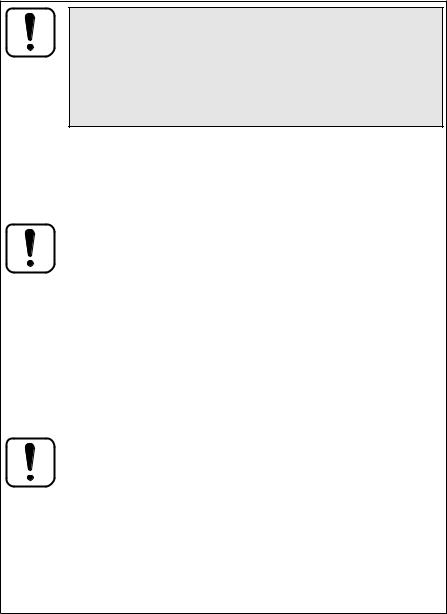
RANGE SELECTION — AT 500 SERIES AND AT 1500 SERIES WITHOUT A SECOND NEUTRAL (PARK); MT 640, MT(B) 643, MT 643R, MT(B) 644, MT 647; HT 740, HT 747
WARNING: If you leave the vehicle and the engine is running, the vehicle can move suddenly and you or others could be injured. If you must leave the engine running, do not leave the vehicle until you:
•Put the transmission in N (Neutral)...and
•Apply the parking brake and emergency brakes and make sure they are properly engaged...and
•Chock the wheels and take any other steps necessary to keep the vehicle from moving.
|
R |
|
Use this to back the vehicle. Completely stop the vehicle before shifting |
||||
|
|
|
|
from a forward range to R (Reverse) or from R (Reverse) to a forward |
|||
|
|
|
|
range. The reverse warning signal is activated when the shift selector is in |
|||
|
|
|
|
this position. Reverse has only one range. Reverse operation also |
|||
|
|
|
|
provides the greatest tractive advantage. |
|||
|
|
|
|
|
|
|
|
|
|
|
|
|
|
|
|
|
|
|
|
|
|
|
|
|
|
|
|
|
WARNING: If you let the vehicle coast in N (Neutral), there is no |
|
|
|
|
|
|
|
engine braking and you could lose control. Coasting can also cause |
|
|
|
|
|
|
|
severe transmission damage. To help avoid injury and property damage, |
|
|
|
|
|
|
|
do not allow the vehicle to coast in N (Neutral). |
|
|
|
|
|
|||||
|
|
|
|
|
|
|
|
|
|
|
|
|
|
|
|
|
N |
|
Use this position when you start the engine. If the engine starts in any |
||||
|
|
|
|
other position, the neutral start switch is malfunctioning. Neutral position |
|||
|
|
|
|
is also used during stationary operation of the power takeoff (if your |
|||
|
|
|
|
vehicle is equipped with a PTO). |
|||
|
|
|
|
|
|
|
|
|
D |
|
The transmission will initially attain 1st range and, as vehicle speed |
||||
|
|
|
|
increases, the transmission will upshift to 2nd range, 3rd range, and |
|||
|
|
|
|
4th range automatically. As the vehicle slows down, the transmission will |
|||
|
|
|
|
downshift to the correct range automatically. |
|||
|
|
|
|
|
|
|
|
|
|
|
|
|
|
|
|
|
|
|
|
|
|
|
|
|
|
|
|
|
WARNING: If you just downshift or just use service brakes when going |
|
|
|
|
|
|
|
downhill, you can lose control and cause injury and property damage. To |
|
|
|
|
|
|
|
help avoid loss of control, use a combination of downshifting, braking, |
|
|
|
|
|
|
|
and other retarding devices. Downshifting to a lower transmission range |
|
|
|
|
|
|
|
|||
|
|
|
|
|
increases engine braking and helps you to maintain control. The |
|
|
|
|
|
|
|
transmission has a feature to prevent automatic upshifting above the |
|
|
|
|
|
|
|
lower range selected. However, during downhill operation, if engine |
|
|
|
|
|
|
|
governed speed is exceeded in the lower range, the transmission may |
|
|
|
|
|
|
|
upshift to the next higher range. This will reduce braking and could |
|
|
|
|
|
|
|
cause a loss of control. Apply the vehicle brakes or other retarding |
|
|
|
|
|
|
|
device to prevent exceeding engine governed speed in the lower range |
|
|
|
|
|
|
|
selected. |
|
|
|
|
|
|
|
|
|
|
9
RANGE SELECTION — AT 500 SERIES AND AT 1500 SERIES WITHOUT A SECOND NEUTRAL (PARK); MT 640, MT(B) 643, MT 643R, MT(B) 644, MT 647; HT 740, HT 747 (cont’d)
3 |
Occasionally, the road, load, or traffic conditions will make it desirable to |
|
2 |
restrict the automatic shifting to a lower range. (When conditions |
|
improve, return the selector to the normal D (Drive) position.) These |
||
positions also provide greater engine braking for going down grades (the |
||
|
||
|
lower the range, the greater the braking effect). |
|
|
|
|
1 |
Use this range when pulling through mud and snow or driving up or down |
|
|
steep grades. This range provides the vehicle with maximum driving |
|
|
power and maximum engine braking power. |
|
|
|
10
